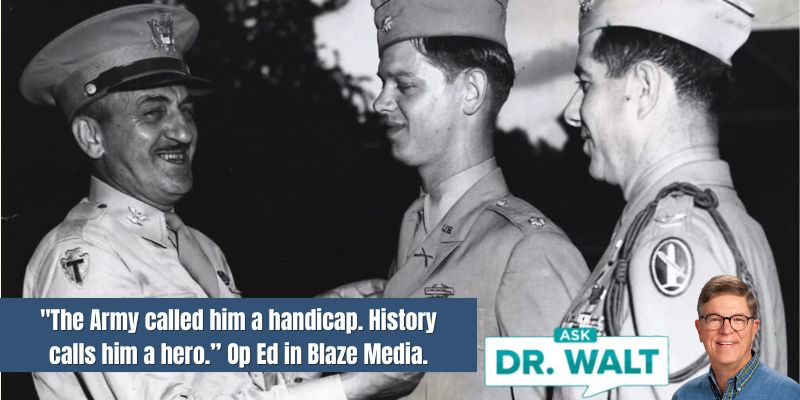
January 22, 1945 — A frozen hell would begin at midnight
January 22, 2025
January 23, 1945, Part 2 — The cost of the mistake was only beginning to dawn on Phil and his men
January 23, 2025January 23, 1945, Part 1 — Angels, doughnuts, and a mistake that led to a colossal loss of GIs
Past midnight, Phil’s 3rd Battalion, commanded now by Major Robert B. Pridgen, trudged slowly through the deep snow, cutting southeast through a thick forest known as the Forêt Communale de Colmar, or Community Forest of Colmar.[1]

Each rifleman, in addition to his semiautomatic M1, carried four bandoleers of ammunition, three fragmentation grenades, one white phosphorous grenade, a day’s worth of C-rations,[2] one blanket, one shelter-half, toilet articles, packs of cigarettes, and other miscellaneous personal items, including letters and pictures from home.
The clouds briefly parted at one point, revealing moonlight almost bright as day, which made the snow and ice sparkle. Phil was walking single file with his men, each one careful to step in the tracks of the point man.
That way, he thought grimly, they’d only lose one man if one of the soldiers stepped on a mine.
Phil heard a loud pop and instinctively ducked. In half a second, he knew what had happened. The lead soldier had stepped on a mine. The sound was the cap going off—meaning, thank God, the main charge didn’t explode. The detonation of the small cap stung the man’s foot, but he wasn’t hurt.
Skirting the minefield, the men continued through the forest, crossing three waist-deep streams and advancing steadily as their frozen pants stuck to their legs. Heavy snow began to fall, and the temperature dropped to fifteen degrees below zero.
At least the Colmar forest cut the wind, which made the advance more tolerable.
Sergeant Beardslee ran back to Phil and Ross. “Sirs, you’re not going to believe what we found,” he said.
They walked forward to find a surreal scene that magically appeared in a forest clearing with thick swirling fog—almost like a fantastic dream or mirage.
“Looky there, Daddy-O!” Ross exclaimed.
In disbelief, they saw three Jeeps parked by the side of the road with Red Cross girls passing out hot coffee and doughnuts. The American GIs could not believe their good fortune. The cute young women had so many pastries that the men put extras in their packs for later.
The soldiers moved on without encountering any enemy resistance. At daylight, they broke out of the woods near the Ill River. They were astonished to find that they were not more than fifty feet from their goal—the Maison Rouge Bridge.[3]
At this point, the river was steeply banked and over sixty feet wide. Their orders were to secure the bridgehead so that two division battalions could pass through and attack southward toward Colmar.
The solid masonry bridge, which had been studied in aerial photographs, could easily hold tanks and armor and was the only available crossing.
Since intelligence indicated the Maison Rouge Bridge was solid and didn’t need any additional support, no bridging material was available to the Dogfaces. Therefore, upon their arrival, Phil and Ross were dumbfounded to see the stone bridge smashed to bits.
“The damn Krauts musta blown it up!” Major Pridgen said as he walked up beside them.
“No, sir,” said Phil. “Looks like it’s been bombed. Probably our Air Corps. And look over there!” He pointed to what appeared to be a newly constructed timber replacement bridge close to the demolished Maison Rouge Bridge.
Pridgen studied the new development. “Phil, Ross, disperse your men around the farm complex. I’ll radio for the engineers to come inspect the bridge.”
Once the bridgehead was secure, the men walked across the replacement bridge. The timbers looked large and stable, but Pridgen wasn’t sure. “Will this bridge hold tanks and armor?” the major asked.
Army engineers arrived quickly and debated whether the replacement bridge was strong enough to allow tanks, artillery, and armor to cross the river. The consensus was that the bridge could not withstand the weight, so no heavy machines could cross until the bridge was reinforced.[4]
This unintentional mistake would lead to a colossal disaster and loss of American lives.
~~~~~
[1] Larimore, At First Light, 187.
[2] The C-ration was an individual combat food ration consisting of tins of meat stew, biscuits, coffee,
tea, and a sweet. A shelter-half is a simple kind of partial tent designed to provide temporary shelter and
concealment.
[3] The Maison Rouge Bridge was named after a prominent red barn and farmhouse found on the other
side—“maison” being the French word for “house” and “rouge” for “red.”
[4] Larimore, Ibid, 187-189.
In case you haven’t read or listened to Dad’s book, you can learn more or order it here.
© Copyright WLL, INC. 2025.



